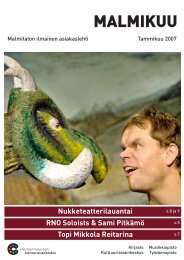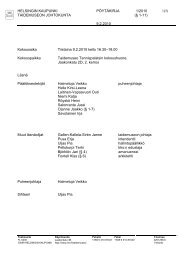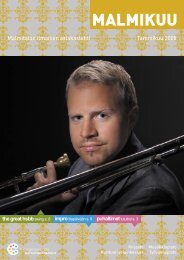Toimintakertomus | Verksamhetsberättelse | Annual Report
Toimintakertomus | Verksamhetsberättelse | Annual Report
Toimintakertomus | Verksamhetsberättelse | Annual Report
Create successful ePaper yourself
Turn your PDF publications into a flip-book with our unique Google optimized e-Paper software.
English summary<br />
The Cultural Office is an administrative body of the City<br />
of Helsinki, established to foster an encouraging<br />
atmosphere and a climate suitable for producing and<br />
experiencing art and culture in Helsinki.<br />
Concentrating and<br />
cooperating help in<br />
times of scarcity<br />
Amidst the clangour of arms, the muses fall silent, as<br />
the Romans used to say. To modernise this and put it<br />
less dramatically: in hard times, hard values hold sway in<br />
administration. In the debate on the city budget, the<br />
importance of culture has not been accentuated. Very<br />
few candidates in the parliamentary elections this spring<br />
chose culture as a campaign theme. Culture is a vitamin:<br />
it is only noticed if it is missing (Paavo Jännes).<br />
Helsinki Cultural Office is a small administrative division<br />
of the city, accounting for about one per cent of the<br />
municipal budget. In many respects the Cultural Office is<br />
safeguard particularly art education for children and young<br />
people, regional interactive cultural work, promoting<br />
multiculturalism and retaining international visits in the<br />
programme. Among the higher-profile recipients of support<br />
are the Helsinki Festival, the Asia in Helsinki Festival, the<br />
Doc.Point documentary festival, the Love and Anarchy<br />
film festival, the Baltic Circle theatre event, the Etnosoi!<br />
festival and the Moving in November dance festival.<br />
Compared with operating grants to institutions of art,<br />
personal grants to artists are marginal. However, as it is<br />
impossible to increase significantly the sum of these, the<br />
Committee, to raise the level of individual grants, has<br />
made a radical decision: each year, grants will be shared<br />
out to only three branches of the arts. The first in line in<br />
2002 were modern dance, light music and media arts.<br />
Alongside focus, the other key word is cooperation. The<br />
paradigm of management by results overemphasised<br />
In times of financial stringency, every sphere of administration<br />
looks into the mirror. In addition to reassessing<br />
priorities, the in-house organisation is reviewed and support<br />
is given for the staff’s ability to bear stress. Target-setting<br />
and consciousness of the significance of the work<br />
were enhanced on the level both of the Cultural Office and<br />
of the units using the Balanced Scorecard methods. The<br />
Management Board has held training sessions of its own,<br />
and a two-day seminar plus a follow-up day about on-thejob<br />
welfare was held for the staff.<br />
The Cultural Office specified its internal administration<br />
by placing the planning of services for the Swedishspeaking<br />
population and the management of Nordic<br />
cooperation in the hands of the development unit.<br />
Methods of monitoring for the use of grants and the<br />
results obtained with them have been improved. Another<br />
sign of streamlining was the removal of the International<br />
Cultural Centre Caisa from two addresses to one, where<br />
the premises are more spacious. Johanna Lindstedt, who<br />
has returned from serving abroad, took over the management<br />
of the Annantalo Arts Centre.<br />
In 2002 the Cultural Office was at its maximum physical<br />
extent. At the turn of the year the centre gave up the<br />
White Hall, its share of the Kurkimäki Community Centre,<br />
and the café in the Lasipalatsi building in order to effect<br />
savings on rent.<br />
Artist in Residence<br />
The three-year agreement on the mutual exchange of artists<br />
between the cities of Helsinki and Brussels and the<br />
Finnish Cultural Institute for Benelux expired at the end of<br />
the year. An exhibition of photography and media art by<br />
three artists from Brussels and three from Helsinki was<br />
staged at the White Hall in December and at the Maison<br />
de l’Art Actuel des Chartreux in Brussels in November.<br />
The Cultural Office operated actively in the following<br />
international networks:<br />
■ Aerowaves<br />
■ ASSITEJ<br />
■ EUnetArt<br />
■ Eurocities<br />
■ European Drama Encounters (Edered)<br />
■ European Forum for Arts and Heritage<br />
■ European Network of Cultural Centres (ENCC)<br />
■ Informal European Theatre Meeting (IETM)<br />
■ International Society for Education through Art (InSEA)<br />
■ Réseau Art Nouveau Network<br />
■ Trans Dance Europe 2000<br />
Cultural Office premises<br />
one of a kind. It has more of an international interface<br />
than any other branch of Helsinki’s municipal administration.<br />
In the international networks of the culture sector,<br />
Helsinki has come to be seen as an expert in taking the<br />
initiative and as a high achiever in implementation. The<br />
latest result is a project approved and financed by the European<br />
Union, the aim of which is to undertake a two-year<br />
comparative survey of quality and quantity in different<br />
cities’ cultural policies.<br />
territoriality, and this is not easily overcome. However, we<br />
have experience – some older, some which we are pleased<br />
to say has accrued in recent years – of cooperation in the<br />
fields of art education and public education with such parties<br />
as the education department, Helsinki City Museum,<br />
the youth work department, and certain theatres and art<br />
colleges. The tangible programme includes cultural courses<br />
for pupils in the upper classes of secondary schools, which<br />
offer cultural cards facilitating access to events and<br />
Yrjö Larmola, Cultural Director<br />
International Networking<br />
Nordic cooperation<br />
Since 1 March 2002, the coordination of Nordic cultural<br />
collaboration has been in the hands of Marie-Louise<br />
REGIONAL CULTURAL CENTRES<br />
Kanneltalo, Malmitalo and Stoa are lively cultural centres<br />
making important contributions to their districts. In addition<br />
to a Cultural Office they have facilities such as a city library,<br />
a workers’ institute and a youth office. Very different<br />
cultural centres are linked by a common interest: that<br />
of prducing a high-quality, affordable programme for their<br />
local residents.<br />
International cooperation is on two levels. We learn from<br />
each others’ way of doing things and we constantly receive<br />
information on offerings and events. In the networks, the<br />
city is represented by officials; during the year under review,<br />
the committee familiarised itself with selection<br />
criteria for support to art institutions, interactive houses of<br />
the arts, multicultural theatre, libraries and an opera<br />
maintained mainly with bought-in services in Amsterdam<br />
and Rotterdam.<br />
Helsinki City Board requires administrative sectors to<br />
focus on their core functions. The Cultural Office’s<br />
activities are comprised of financial support for culture,<br />
providing arts venues and events, and art education. As it<br />
focuses its increasingly scanty financing and plans its<br />
activities, the Cultural and Library Committee seeks to<br />
programme calendars.<br />
The Annantalo Arts Centre has developed a distinctive,<br />
varied programme of art education for a decade and a half,<br />
and this has been made available at the other regional<br />
cultural centres for some years. Similarly, now that the International<br />
Cultural Centre Caisa has received new<br />
premises, forms of working are being developed for<br />
cooperation by people from different cultural backgrounds<br />
and for the integration of newcomers. These ideas are also<br />
expected to spread into wider use. Culture does not patent<br />
its achievements in the realm of ideas.<br />
One area of development is to reach out to those at risk<br />
of exclusion, encouraging them to become users of the<br />
cultural offerings. Partners have been found for this, but<br />
the work is still in its early days.<br />
Blåfield. She has attended various meetings held by the<br />
Nordic capital cities as the representative of Helsinki<br />
Cultural Office. An important sphere of her work has<br />
been to provide information and advisory services<br />
related to grants, scholarships and possibilities for<br />
cooperation.<br />
In the autumn a series of conferences on Nordic cultural policy<br />
began in Oslo. This is based on a broad-spectrum research<br />
project carried out 1998 - 2002, one of the financial backers of<br />
which was the Nordic Cultural Fund. Seminars specific to<br />
particular countries are held on the basis of analyses and<br />
reports, at which the cultural policy of each country is examined<br />
and topical national research projects are presented. The<br />
planning for the Helsinki conference in 2003 was started in<br />
cooperation with the Nordic Institute in Finland.<br />
Kanneltalo<br />
Kanneltalo is the Cultural Centre of Western Helsinki. Its<br />
programme strongly features music and children’s culture.<br />
Kanneltalo was ten years old in August. The anniversary<br />
was marked with a special week-long programme, the<br />
planning and implementation of which were performed by<br />
the Cultural Office as well as the building’s other administrative<br />
committees. The festival week reached its climax<br />
with a concert by Mari Palo, Seeli Toivio and eight cellists.<br />
The range of concerts was diverse. The programme<br />
embraced classical music, ethno and jazz as well as several<br />
cross-genre assemblies. The Kamari 21 series of chamber<br />
music performances continued with success. The series<br />
included performances by artists such as Cecilia Zilliacus<br />
and Bengt-Åke Lund (Sweden), Pekka and Jaakko<br />
26 ENGLISH SUMMARY 2002 ENGLISH SUMMARY 2002<br />
27

















